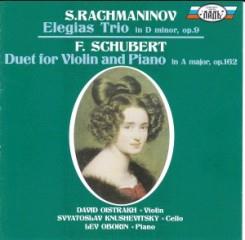D. Oistrakh - L.Oborin - S. Knushevitsky: Schubert - Rachmaninov (1993)
D. Oistrakh - L.Oborin - S. Knushevitsky: Schubert - Rachmaninov (1993)

Franz Schubert - Duet for Violin and Piano in A major, op.162 1. I. Allegro moderato 8:49 2. II. Scherzo. Presto 4:20 3. III. Andantino 4:20 4. IV. Allegro vivace 5:00 David Oistrah - violin Lev Oborin – piano Sergey Rachmaninov - Trio No. 2 In D Minor, Op. 9, For Piano, Violin And Cello, "Elegiac" 5. I. Moderato - Allegro moderato 18:37 6. II. Quasi variazione 19:48 7. III. Allegro risoluto 7:12 Lev Oborin – piano David Oistrah - violin Svyatoslav Knushevitsky – cello
Franz Schubert - Duet for Violin and Piano in A major.
Not published until 1851, this work of Schubert's early maturity fully deserves the designation "duo" appended by the publisher; unlike Schubert's earlier works for violin and piano, this sonata makes the keyboard a full partner and displays the composer's increasing confidence in writing for piano.
The first of the four movements is an Allegro moderato, in which a few bars of amiable piano introduction become the ambling accompaniment to a low-key, songful violin theme. Soon both instruments offer a much more animated treatment of this material and then a new idea that is essentially an elaboration of the opening piano figure. After an exposition repeat, Schubert subjects these themes to a brief development and standard recapitulation.
The Scherzo (Presto) is a rollicking piece in which a little piano fanfare launches a scurrying violin figure. The music lurches through some surprising key changes, often coming to a full stop before continuing with quite different material. Embedded between the E major outer sections of this movement is a playful C major trio, featuring highly chromatic writing for the violin.
These high spirits dissipate in time for the Andantino, a mostly lyrical dialog that drifts from C major to D flat and ultimately A flat, with a few piano trills, violin double stops (nothing to intimidate the amateur domestic players for which this sonata was probably intended), and brief, extroverted outbursts along the way.
Finally comes the Allegro vivace, in which the spirit of the earlier scherzo returns, complete with a short, leaping motif to get the movement off to a joyful start. Again, the music is full of hesitations that signal new harmonic and melodic directions; Schubert packs substantial adventure into this movement's four minutes. --- James Reel, allmusic.com
There seems to be an unwritten rule for Russian composers that the piano trio is a vehicle especially suited for tributes or memorials. Tchaikovsky, who is memorialized in this Rachmaninoff work, wrote his own Piano Trio as a tribute to the late Nikolai Rubinstein; Anton Arensky wrote his Trio No. 1 in memory of cellist Karl Davidov, and Shostakovich evoked chilling images of the Soviet death camps in his Trio No. 2, which is dedicated specifically to his friend Ivan Sollertinsky.
This Trio is early music from Rachmaninoff (composed in his 20th year), but his signature style is already in evidence. His most famous shorter work, the Prelude in C-sharp minor, had been composed in 1892. He had completed his opera Aleko and his symphonic poem The Rock had been praised by Tchaikovsky, who expressed his interest in conducting it. Rachmaninoff himself was conducting Aleko in Kiev and missed the premiere of Tchaikovsky’s Sixth Symphony in October 1893; just a few days later, the great Russian composer was dead.
Along with all of the musical world, Rachmaninoff was shocked and saddened by Tchaikovsky’s death at age 53. Modeling his Elegiac Trio No. 2 on the three-movement structure of Tchaikovsky’s Trio, he opened the work with a Moderato section that returns much later to close the final movement. The composer, already acknowledged as a virtuoso pianist, wrote a demanding piano part for himself, including an extended cadenza-like passage. The second movement, again, as in Tchaikovsky’s Trio, is a set of variations, using a somber theme from The Rock, the work Tchaikovsky was to have conducted. --- Dennis Bade, laphil.com
download (mp3 @320 kbs):
yandex 4shared mega mediafire uloz.to cloudmailru gett








